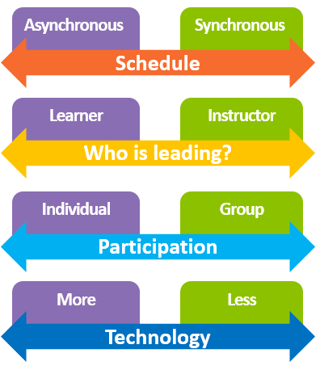
Update 3/20/2020:
If you are here due to the COVID-19 pandemic, you've come to the right place. We have years of experience delivering training in remote modalities. Read on.
We are seeing a spike in requests for Microsoft Teams training because of the increasing need to work from home. Maintaining effectiveness and productivity while working from home can be a challenge. We can train your organization FAST, and 100% online.
If you are interested in exploring the most effective training methods for your business needs, then this post is for you!
Original Post
Sometimes called "hybrid learning," blended learning uses a mix of training strategies to deliver the best results. Any program that combines traditional classroom training with computer-based or online training is reaping the benefits of blended learning.
4 spectrums to consider when blending training strategies
Different training methods vary across these 4 spectrums. For example, traditional classroom training is pretty much at the far right of each spectrum, while most online video training falls at the far left of each spectrum. Other methods, like online classes and webinars, are somewhere in the middle. The benefits of blended learning allow you to mix and match according to your needs.
 Schedule
Schedule
Some training methods are synchronous, meaning everybody participates together at a set time. Others are asynchronous, and participants do not need to adhere to a set time.
Who is leading?
This aspect of training considers who is leading the learner through the material.
Instructor-led training is great for complex topics, where it’s useful to offer in-depth explanations or expert opinion in immediate response to questions as they arise. Self-paced training, on the other hand, is more of an individual pursuit and gives the learner control over when to move ahead in the material.
Participation
Some training methods are aimed at learning in groups, while others are geared toward individual participation.
Technology
It’s almost impossible these days to hold training without the use of any technology, but there is still a range from less to more. A physical classroom with a whiteboard and paper hand-outs is on the low end of this spectrum, while an online classroom with VoIP and electronic books and virtual labs is clearly at the other end.
The benefits of blended learning
OK, now that we have a framework for understand what blended learning is, let’s get into the key advantages.
1. Flexibility
A blended learning approach provides ultimate flexibility in presenting content. Complex topics can be presented in the classroom, while other subject matter can be available online. With an online component, you’ll also increase flexibility and convenience over how and when your employees participate in training.
2. Effectiveness
Garrison and Kanuka (and I’m sure countless other academics) have studied blended learning. Their research concludes that “blended learning … has the proven potential to enhance both the effectiveness and efficiency of meaningful learning experiences.”
3. Efficiency
With a well-planned blended learning strategy, you can efficiently and quickly deliver training to a broad audience. And with digital assets such as videos and recordings and eBooks, the potential for re-use is huge. You can easily help more people get up-to-speed after the initial rounds of training have passed.
Related Blog Post: Increasing Business Efficiency Using Office 365
4. Cost-effectiveness
Most of us like strategies that can save our organization money. And blended learning is one of them! Including more online options in your training program saves on travel and missed work. When you are hosting live events online, you eliminate employee and instructor travel costs. When the venue is your own desk, that’s clearly a savings over large rooms!
Related Blog Post: 5 Office 365 Features that can Increase Productivity
5. Personalization
Any training that is not well implemented can create an isolating, cookie-cutter, impersonal learning experience. But the good news is that a well-crafted blended solution can provide a seamless transition from classroom to computer or vice-versa. You can design ways of continuing discussion themes and personalizing content to a person’s specific job or interests.
6. Extended reach
Almost always, creating a blended learning strategy reduces classroom teaching time. By digitizing the expertise of talented instructors or subject-matter experts, you can reach more people with high-quality content at a fraction of the cost. That frees up knowledgeable instructors to offer more classes, or create more training content, or work on other things.
7. Covers all learning styles
It’s always important to take learning styles into account then designing training for adults. Effective blended learning is a “best of all worlds” solution that can help you cater to all learning styles through a variety of mediums and techniques.
Are there disadvantages to blended learning?
The most noteworthy disadvantage that we come across is that blended learning often relies heavily on technology to deliver online learning experiences.
The digital tools and online assets need to be reliable, easy to use and up-to-date for them to have meaningful impact. Technical issues encountered by employees, whether perceived or real, can be a significant barrier, so it is important to put measures in place for high availability and strong technical support.
Want to experience blended-learning first hand?
KnowledgeWave provides blended options for software training. A KnowledgeWave membership incorporates on-demand videos, instructor-led webinars, and live online classes. Learn more about the KnowledgeWave Learning Site and our blended approach to software training and online learning here.

 Schedule
Schedule






